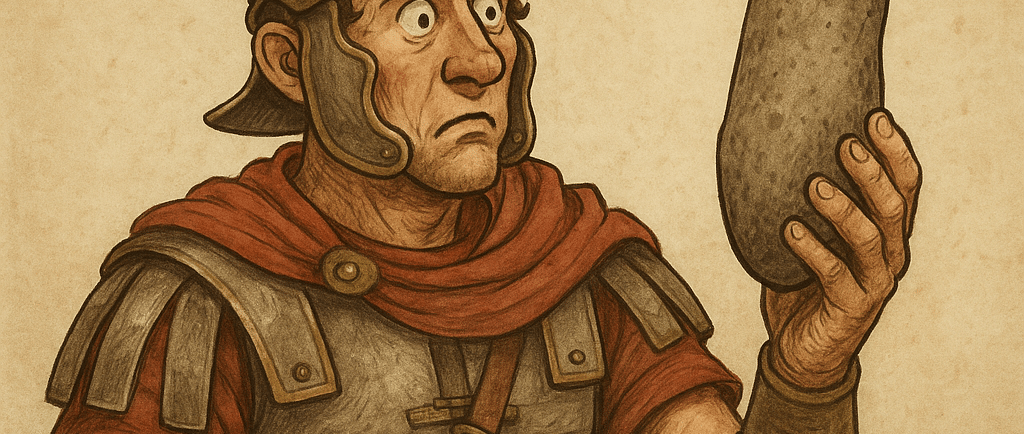Sharpest Phallus in History: How a Stone Penis Kept Swords Battle-Ready
This Roman stone phallus wasn’t just symbolic—it was functional. Archaeologists reveal it was used to sharpen swords. Ancient Rome never disappoints.
Penis Friends
8/6/20253 min read


Introduction: A Hard Truth from History
Welcome to another installment of “You Won’t Believe What the Romans Were Up To,” proudly presented by your friends at Penis Friends—where ancient tools meet modern giggles.
This time, we travel to a Roman fort in Spain, where archaeologists unearthed a stone phallus. Nothing new, right? The Romans were obsessed with carving genitalia into anything that stood still long enough. But this particular piece of stone manhood had a sharp secret.
Literally.
Because this wasn’t just a good-luck charm. It was a whetstone.
Yes. Roman soldiers were sharpening their swords—on a rock-hard penis.
And suddenly, your multitool doesn’t seem so multi, does it?
🛡️ The Discovery: Rock-Hard and Ready to Go
Unearthed near León, Spain, in a Roman military encampment, this artifact was first classified as an “apotropaic object”—a fancy way of saying “magical dick that keeps bad vibes away.”
But recent research revealed deeper grooves—no, not like that. Actual wear patterns consistent with repeated sharpening of metal objects. Made from coarse sandstone, this “equipment” was both form and function.
So yeah—Romans were literally prepping for battle with help from a sculpted stone shaft.
🔪 Blade Meets Boner: The Whetstone Revelation
When scientists examined the wear marks, they didn’t find ritual polish or weather erosion—they found good old-fashioned metal-on-rock friction. This was a tool, not a trinket.
Roman legionaries, ever the practical bunch, likely used this phallic artifact to keep their gladii and daggers in fighting shape. Talk about cutting-edge masculinity.
One can almost hear it:
“Hey Brutus, toss me the tip—I need to touch up my blade.”
“Not that tip, you idiot.”
🤣 Barracks Banter, Biceps, and Blade Maintenance
If you think soldiers today make dirty jokes, you’d better believe Roman barracks were full of them. Imagine a whole squad of warriors gathered around one chiseled shaft, laughing as they sharpened their weapons and cracked the ancient equivalent of your group chat’s worst jokes.
And honestly, this whole setup is peak Penis Friends energy.
A blend of practical absurdity and masculine hilarity? We live for it.
📜 Symbolism Meets Functionality: Rome’s Genius & Junk
To the Romans, a phallus wasn’t just naughty—it was protective, fertile, and powerful. Phallic amulets hung from doorways, armor, and even baby cribs. This whetstone was just the next logical step: protect your soul, protect your sword.
Why settle for a boring rectangular stone when you could have one shaped like your lucky charm?
It’s branding. Ancient-style.
⚔️ What This Rock-Hard Relic Tells Us
This artifact says everything about Roman soldiers:
Practical yet playful
Superstitious yet sharp
Willing to laugh while preparing for war
It’s a reminder that these were real people—not just marble statues with serious expressions—but living, joking, sword-wielding dudes who sharpened metal on stone meat.
And you thought your Leatherman was versatile.
Conclusion: History’s Sharpest Shaft Gets the Penis Friends Seal of Approval
We at Penis Friends tip our helmets to this artifact—not just for its craftsmanship, but for its commitment to multitasking.
Because nothing says "Roman efficiency" like a tool that protects your soul and your steel. And nothing says “Penis Friends” like celebrating the weird, wonderful legacy of functional phalluses throughout history.
So the next time someone questions your taste in content, remind them:
The Romans were sharpening swords on stone wangs 2,000 years ago. We’re just keeping the tradition alive—with less blood and better fonts.
FAQs
Q1: What was the Roman stone phallus used for?
It functioned as a whetstone to sharpen swords, not just a symbolic or decorative item.
Q2: Where was it discovered?
In a Roman military site near León, Spain.
Q3: Why are phallic objects common in Roman archaeology?
They were considered protective, lucky, and powerful—used in charms, carvings, and daily objects.
Q4: What does this artifact reveal about Roman soldiers?
They blended practicality, superstition, and humor into their daily routines—including battle prep.
Q5: How does Penis Friends connect to this story?
Our brand celebrates the absurd, hilarious, and history-backed side of phallic fame. This story is basically our mascot.
